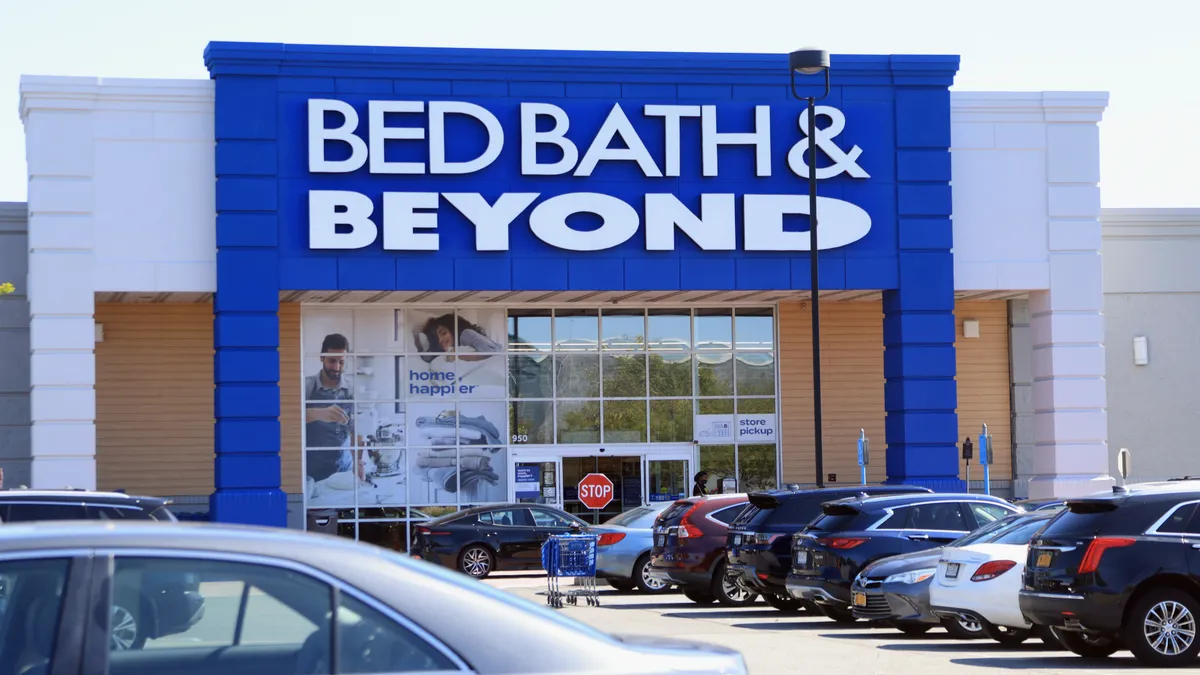Dive Brief:
- Bed Bath & Beyond on Thursday announced it will attempt to raise $300 million though an at-the-market share offering led by B. Riley Securities. The retailer warned that if it can’t raise the full amount, it “will likely force us to file for bankruptcy protection,” according to a Thursday filing.
- Simultaneously, the company said it’s terminating an earlier deal with Hudson Bay Capital Management. That agreement sought to raise over $1 billion to buoy the beleaguered retailer’s operations. Bed Bath & Beyond said that before the deal was terminated, the company had raised $360 million of equity capital, which was used to make a missed debt payment, pay interest on upcoming debt and finance part of the company’s turnaround plans.
- Bed Bath & Beyond also provided its preliminary fiscal fourth quarter results. The company reported net sales of about $1.2 billion, down from $2.1 billion in the year-ago period. Comp sales for Q4 declined in the 40% to 50% range and the company said it had continuing operating losses.
Dive Insight:
The home goods retailer has repeatedly and narrowly avoided bankruptcy in recent months.
In early January, the company issued a “going concern” warning. Later that month, JPMorgan Chase issued the company a default notice and called for immediate repayment of debts under a credit agreement. Around the same time, Bed Bath & Beyond told the Securities and Exchange Commission it didn’t have enough cash to pay down its debts.
At the end of January, the company moved to close its entire 50-store chain of Harmon beauty stores. In early February, Bed Bath & Beyond announced it had secured the financing deal with Hudson Bay. And just this week, news broke that the company is laying off 1,300 workers in New Jersey.
As part of its turnaround plan, the company wants to shrink its store footprint to a “target of 360 top-performing Bed Bath & Beyond stores by the end of April, in addition to our existing 120 BuyBuy Baby stores,” CEO Sue Gove said in a statement this week. In early 2022, the company had 771 Bed Bath & Beyond stores, according to regulatory filings.
Earlier this month, the company proposed a reverse stock split. That strategy, the company said, is intended to "appeal to a broader range of investors to generate greater investor interest in the company." But the move also risks failing to increase the company’s stock price.
As of Monday, the company said it had about 435 million shares of common stock issued and about 295 million shares of common stock available to issue.
An at-the-market offering allows companies that face liquidity issues to raise money quickly by allowing a broker to buy or sell assets at the best available price.
But the newest strategy to keep the company afloat also isn’t a sure thing, with the retailer again warning of a potential bankruptcy filing. Other situations that may force the company into bankruptcy include an inability to execute a reverse stock split or a need to restructure or refinance existing debt.
“It’s hard to survive when you’ve lost your customer base, supplier confidence in your ability to pay them and a heavy debt load in need of refinancing. Add inflation, higher interest rates and an equity market that doesn’t like hail mary passes, and you’ve got a really tough time,” RapidRatings CEO James Gellert said in an email to Retail Dive. “It’s hard to see how they can pull another rabbit out of the hat now that the most recent rabbit is lying by the side of the road. Selling Buy Buy Baby might be their only real option, but that’s been explored and hasn’t happened yet. In a bankruptcy proceeding this may be the only real asset of significant value.”
Still, Gove said Bed Bath & Beyond is “making meaningful progress to improve our business,” and that its also developing a third-party consignment program. The program will allow the company to strengthen its product assortment and expand merchandise availability from supplier partners.














